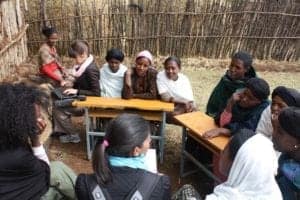When Women’s World Banking launched a new strategy in 2014, we reaffirmed our commitment to ensure that the largest number of low-income women are served well with innovative financial products and services. We knew that in order to accomplish this, we needed a new team that could keep us on track to reach this ambitious goal. Thus, a new department was formed that would lead the charge in terms of understanding the needs of 1.3 billion women worldwide who remain outside the formal financial system. The new Research, Monitoring & Evaluation team, as it is called, aims to understand how we can meet these women’s needs, whether the women who have accessed our financial products are served well, and the financial and social outcomes for women and their families.

Yet in order to reach the 1.3 billion women who are still financially excluded, we needed to go further. Research as we now envision it will go beyond market research linked to product development. We are now exploring new markets and segments. Where are the largest number of un- and under-banked women? Do they own their own businesses? Are these businesses formal or informal? Are they salaried, working in factories or on farms? Are they young mothers who worry about lost income when a child is sick, or are they older and worried about their future when they can no longer work? The new Research mandate is to identify a wider variety of markets, partners, products and services, both financial and non-financial, that can help expand financial inclusion for women.
 Research is also needed to understand client outcomes and how women’s financial behavior translates into positive benefits for themselves, their families and communities. At Women’s World Banking, we believe that increased access to financial products and services brings women the knowledge, skills, confidence, and motivation to advance life goals. We have seen that when women have access to financial services and more control over their incomes they also tend to have more bargaining and decision-making power in their families. Yet, we need further evidence on how empowerment is linked to financial services.
Research is also needed to understand client outcomes and how women’s financial behavior translates into positive benefits for themselves, their families and communities. At Women’s World Banking, we believe that increased access to financial products and services brings women the knowledge, skills, confidence, and motivation to advance life goals. We have seen that when women have access to financial services and more control over their incomes they also tend to have more bargaining and decision-making power in their families. Yet, we need further evidence on how empowerment is linked to financial services.
We are making progress in many of these areas. Already we are exploring new markets to assess how we can positively impact women’s financial inclusion. A recent study of China identified potential entry strategies for partnering with financial service providers, and a feasibility study in Brazil has created an opportunity for further research on the supply of microinsurance products in the market.
 We are also looking beyond the microentrepreneur to understand other segments of low-income women. We conducted a global scan of women-led small and medium enterprises (SMEs), identifying best practices for financial institutions to serve this growing and financially under-served market. In partnership with BSR in India, we studied low-income garment factory workers “in-transition” between the informal and formal financial system. Women factory workers have limited control over their earnings, coupled with little financial education. These findings enabled us to create a new project plan to deliver financial education and products that ensure the needs of these women are met.
We are also looking beyond the microentrepreneur to understand other segments of low-income women. We conducted a global scan of women-led small and medium enterprises (SMEs), identifying best practices for financial institutions to serve this growing and financially under-served market. In partnership with BSR in India, we studied low-income garment factory workers “in-transition” between the informal and formal financial system. Women factory workers have limited control over their earnings, coupled with little financial education. These findings enabled us to create a new project plan to deliver financial education and products that ensure the needs of these women are met.
Measuring how well we are doing remains the most ambitious part of our ever-growing Research agenda. Last month we launched our first “client outcomes survey” with our partner Diamond Bank in Nigeria. The quantitative survey will evaluate previous access to financial services; savings behavior and goals; business activity and use of credit; control over product use and household outcomes such as consumption smoothing; and improvements in housing conditions, health and children’s education.
We will be doing a series of blogs to discuss some of these new initiatives, and look forward to continuing to build out a robust Research agenda that will enable Women’s World Banking to serve more women and serve them well.
This research and blog series is presented with support from a grant from the Citi Foundation.



